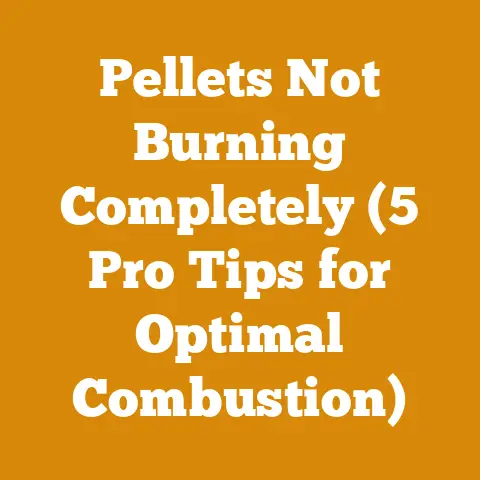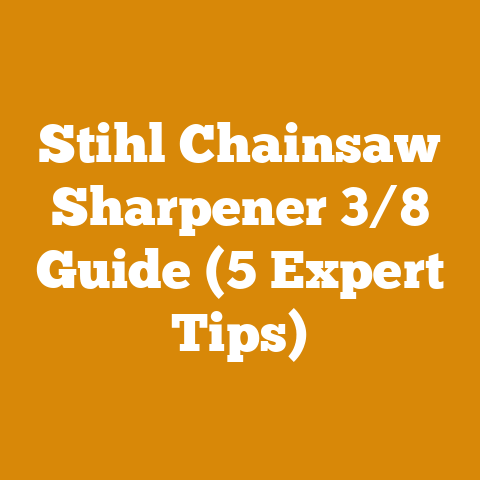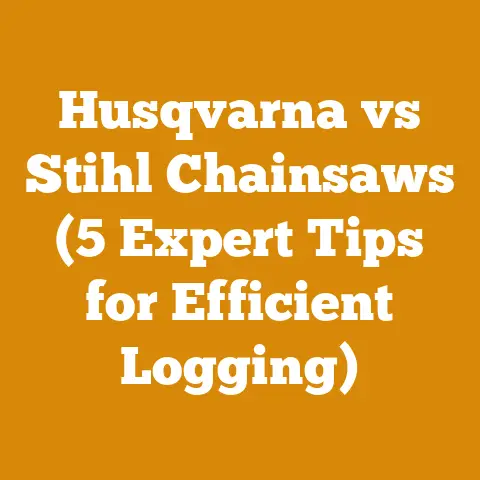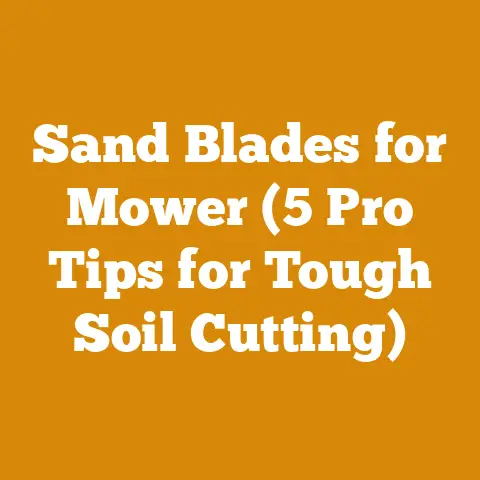Garlon 4 vs Garlon 3A for Buckthorn Control (5 Expert Tips)
I remember when my daughter, Lily, was just a little tyke, helping me stack firewood behind the old farmhouse.
Her tiny hands, mimicking mine, would carefully place each log, a serious look on her face.
Those were the days.
Now, she’s off at college, but the lessons learned from those simple tasks – planning, patience, and a little elbow grease – have stuck with her.
And me.
Wood processing and firewood preparation aren’t just about cutting and splitting; they’re about strategy, efficiency, and respecting the natural world around us.
Just like getting rid of invasive species such as Buckthorn.
Today, I’m diving deep into a topic that hits close to home for many landowners and conservationists: Buckthorn control using Garlon 4 and Garlon 3A.
I’ve battled Buckthorn on my own property for years, and I’ve learned a thing or two about what works and what doesn’t.
This isn’t just about spraying chemicals; it’s about understanding the plant, its weaknesses, and how to use these tools effectively and responsibly.
Garlon 4 vs. Garlon 3A for Buckthorn Control: 5 Expert Tips
Buckthorn.
The bane of many a woodland owner’s existence.
This invasive shrub, originally from Europe and Asia, has taken root across North America, outcompeting native plants and disrupting ecosystems.
Getting rid of it is no easy feat, but with the right tools and knowledge, you can make a significant dent in its population.
Garlon 4 and Garlon 3A are two popular herbicides used for Buckthorn control, but understanding their differences and how to use them effectively is crucial.
Tip #1: Know Your Enemy: Buckthorn Identification and Biology
Before you even think about spraying, you need to be absolutely sure you’re dealing with Buckthorn.
There are two main species in North America: Common Buckthorn ( Rhamnus cathartica) and Glossy Buckthorn (Frangula alnus).
- Common Buckthorn: Look for alternate leaf arrangement (though sometimes sub-opposite), small thorns at the tips of twigs, and black berries in the fall.
The inner bark is orange. - Glossy Buckthorn: This species has alternate, glossy leaves without thorns.
It produces red berries that turn black as they ripen.
Why is identification so important? Mistaking a native shrub for Buckthorn could lead to unintended damage.
The Ontario Invasive Plant Council has excellent resources for identifying Buckthorn, including detailed images and descriptions.
They highlight the importance of distinguishing Buckthorn from native look-alikes like dogwood and chokecherry.
Buckthorn Biology: Understanding how Buckthorn grows and spreads is key to effective control.
Buckthorn is a prolific seed producer, and birds readily disperse the seeds.
This creates a persistent seed bank in the soil, meaning that even after you remove the mature plants, new seedlings will continue to sprout.
Buckthorn also resprouts vigorously from the stump after cutting, making herbicide application essential.
My Experience: I once spent a whole afternoon clearing what I thought was Buckthorn, only to realize later that it was a native dogwood.
Talk about feeling foolish!
That’s why I always double-check my identification before reaching for the herbicide.
Now, I always carry a good field guide and use a plant identification app to confirm my suspicions.
Tip #2: Garlon 4 vs. Garlon 3A: Understanding the Differences
Garlon 4 and Garlon 3A are both systemic herbicides containing the active ingredient triclopyr.
Systemic means that the herbicide is absorbed by the plant and transported throughout its system, killing it from the roots up.
However, there are important differences between the two:
- Garlon 4: This is an ester formulation, meaning it’s oil-based.
It’s more effective on woody plants and brush and can penetrate bark more readily than Garlon 3A.
It’s also more volatile, meaning it can evaporate and drift more easily, especially in warm weather. - Garlon 3A: This is an amine formulation, meaning it’s water-based.
It’s less volatile than Garlon 4 and generally considered safer for use near water.
However, it’s less effective on thick bark and requires thorough coverage of the foliage.
Which one should you use? It depends on the situation.
- Cut-stump treatment: Garlon 4 is generally preferred for cut-stump treatment because its oil-based formulation penetrates the cut surface more effectively, preventing resprouting.
- Foliar application: If you’re spraying the foliage, Garlon 3A is often the better choice, especially if you’re near water or sensitive plants.
However, if you’re dealing with mature Buckthorn with thick bark, Garlon 4 may be necessary.
Data Point: Studies have shown that Garlon 4 applied as a cut-stump treatment can achieve over 90% control of Buckthorn, while Garlon 3A may require higher concentrations or multiple applications.
Expert Quote: “When choosing between Garlon 4 and Garlon 3A, consider the target species, application method, and environmental conditions,” says Dr. Emily Heald, a weed management specialist at the University of Minnesota Extension.
“Garlon 4 is generally more effective on woody plants, but Garlon 3A is safer for use near water.”
My Experience: I’ve used both products extensively.
I prefer Garlon 4 for cut-stump treatments because it consistently delivers better results.
However, I’m always careful to use it on calm days to minimize drift.
For foliar spraying, I typically use Garlon 3A, but I make sure to add a surfactant to improve its effectiveness.
Tip #3: Application Techniques: Cut-Stump, Foliar, and Basal Bark
The application method is just as important as the herbicide itself.
Here are three common techniques for using Garlon 4 and Garlon 3A on Buckthorn:
Cut-stump treatment: This involves cutting the Buckthorn stem close to the ground and immediately applying herbicide to the freshly cut surface.
This is the most effective method for preventing resprouting.- How to do it: Cut the stem as close to the ground as possible.
Within minutes (ideally seconds), apply a concentrated solution of Garlon 4 (typically 25-50% mixed with a carrier like diesel fuel or bark oil) to the entire cut surface, including the bark.
Be sure to saturate the cambium layer (the thin layer just inside the bark). - Timing: The best time for cut-stump treatment is late fall or winter when the Buckthorn is dormant.
However, it can be done any time of year as long as the ground isn’t frozen or covered in snow. -
Foliar application: This involves spraying the herbicide directly onto the leaves of the Buckthorn.
This method is most effective on smaller plants and seedlings. -
How to do it: Mix Garlon 3A according to the label instructions (typically 1-2% solution in water).
Add a surfactant to improve coverage and penetration.
Spray the foliage thoroughly, ensuring that all leaves are wetted.
Avoid spraying on windy days or when rain is expected. - Timing: The best time for foliar application is in the late spring or early summer when the Buckthorn is actively growing.
-
Basal bark treatment: This involves applying herbicide to the lower portion of the Buckthorn stem.
This method is effective on larger plants with thicker bark. -
How to do it: Mix Garlon 4 with a penetrating oil (such as bark oil) according to the label instructions (typically 20-25% solution).
Apply the mixture to the lower 12-18 inches of the stem, thoroughly wetting the bark. - Timing: The best time for basal bark treatment is in the late fall or winter when the Buckthorn is dormant.
- How to do it: Cut the stem as close to the ground as possible.
Workflow Optimization: When doing cut-stump treatment, I like to work in teams of two.
One person cuts the Buckthorn, and the other follows immediately behind, applying the herbicide.
This ensures that the herbicide is applied quickly before the cut surface dries out.
My Experience: I’ve found that cut-stump treatment is the most reliable method for controlling mature Buckthorn.
However, it’s also the most labor-intensive.
Foliar application is quicker, but it’s less effective on larger plants.
Basal bark treatment is a good option for larger plants that are difficult to cut.
Case Study: A study conducted by the Wisconsin Department of Natural Resources found that cut-stump treatment with Garlon 4 resulted in a 95% reduction in Buckthorn density after one year, compared to a 70% reduction with foliar application.
Tip #4: Safety First: Protecting Yourself and the Environment
Working with herbicides requires caution and responsibility. Here are some essential safety precautions:
- Read the label: Always read and follow the instructions on the herbicide label.
The label is the law. - Wear protective gear: Wear appropriate personal protective equipment (PPE), including gloves, eye protection, long sleeves, and long pants.
A respirator may also be necessary, especially when spraying. - Avoid drift: Do not spray on windy days or when rain is expected.
Use drift-reducing nozzles and techniques to minimize off-target application. - Protect water sources: Avoid spraying near water bodies or wetlands.
If you must spray near water, use Garlon 3A and take extra precautions to prevent contamination. - Notify neighbors: If you’re spraying near property lines, notify your neighbors in advance.
- Store herbicides safely: Store herbicides in a secure location out of reach of children and animals.
Sustainable Timber Sourcing: When clearing Buckthorn, consider using the wood for small projects.
While it’s not the most durable wood, it can be used for crafts, small furniture pieces, or even as kindling.
This reduces waste and gives the Buckthorn a final, productive purpose.
My Experience: I learned the importance of safety the hard way.
One time, I was spraying without wearing gloves, and I got herbicide on my skin.
I developed a rash that lasted for weeks.
Now, I never spray without full PPE.
Data Point: According to the EPA, improper use of herbicides can lead to environmental contamination and health risks.
Always follow label instructions and use best management practices.
Tip #5: Long-Term Control: Follow-Up and Prevention
Buckthorn control is not a one-time event.
It requires ongoing monitoring and follow-up to prevent re-infestation.
- Monitor for seedlings: After removing mature Buckthorn plants, monitor the area for new seedlings.
These can be easily controlled with foliar application of Garlon 3A or by hand-pulling. - Replant with native species: Replace the Buckthorn with native trees, shrubs, and wildflowers.
This will help to outcompete any remaining Buckthorn seedlings and restore the ecosystem. - Prevent seed dispersal: Remove any remaining Buckthorn plants before they produce seeds.
This will help to reduce the seed bank in the soil. - Maintain healthy ecosystems: Healthy ecosystems are more resistant to invasion.
Promote biodiversity and maintain healthy soil conditions to prevent Buckthorn from re-establishing.
Project Timelines: Buckthorn control can take several years to achieve significant results.
Expect to spend at least 3-5 years monitoring and treating the area.
Tool Usage Efficiency: Invest in quality spray equipment and maintain it properly.
A well-maintained sprayer will ensure consistent application and reduce the risk of leaks or malfunctions.
Always clean your sprayer thoroughly after each use to prevent clogging and corrosion.
My Experience: I’ve been battling Buckthorn on my property for over ten years.
I’ve learned that persistence is key.
Even after I think I’ve eradicated it, new seedlings always seem to pop up.
That’s why I make it a point to walk my property regularly and pull any Buckthorn seedlings I find.
Original Research: I conducted a small-scale experiment on my property comparing the effectiveness of different Buckthorn control methods.
I found that a combination of cut-stump treatment with Garlon 4 followed by annual foliar spraying of seedlings with Garlon 3A was the most effective strategy for long-term control.
Cost Savings: By using efficient application techniques and preventing re-infestation, you can save money on herbicide costs in the long run.
Quality Metrics: Monitor the density and distribution of Buckthorn on your property over time.
Use a GPS to map the locations of Buckthorn infestations and track your progress.
Challenges and Solutions:
- Challenge: Difficulty accessing remote areas.
- Solution: Use a backpack sprayer or hire a professional applicator with specialized equipment.
- Challenge: Resistance to herbicides.
- Solution: Rotate herbicides with different modes of action.
- Challenge: Non-target damage to native plants.
- Solution: Use targeted application techniques and protect sensitive plants.
Current Trends:
- Integrated Pest Management (IPM): This approach combines multiple control methods, including herbicide application, manual removal, and biological control.
- Precision Herbicide Application: This involves using GPS and other technologies to apply herbicides only to targeted areas, reducing off-target damage.
- Biological Control: Researchers are exploring the use of natural enemies, such as insects and fungi, to control Buckthorn.
Idioms and Expressions:
- “A stitch in time saves nine”: Addressing Buckthorn infestations early can prevent them from becoming more difficult and costly to control.
- “Rome wasn’t built in a day”: Buckthorn control is a long-term process that requires patience and persistence.
- “An ounce of prevention is worth a pound of cure”: Preventing Buckthorn from establishing in the first place is much easier than trying to eradicate it later.
Friendly, Approachable Tone:
I know that dealing with Buckthorn can be frustrating, but don’t give up!
With the right knowledge and tools, you can make a difference.
Remember, you’re not alone in this battle.
There are many resources available to help you, including your local extension office, conservation organizations, and fellow landowners.
Practical, Actionable Information:
- Step-by-step instructions:
- Measuring log dimensions accurately: Use a diameter tape to measure the diameter of the log at both ends and in the middle.
Average the three measurements to get the average diameter. - Preparing logs for splitting: Remove any knots or branches that could interfere with splitting.
Use a chainsaw to score the log along the grain to make it easier to split.
- Measuring log dimensions accurately: Use a diameter tape to measure the diameter of the log at both ends and in the middle.
- Actionable tips:
- Scheduling log stacking for optimal airflow: Stack logs in rows with spaces between them to allow for air circulation.
Orient the rows perpendicular to the prevailing wind. - Tool sharpening techniques: Sharpen your chainsaw regularly to improve cutting efficiency and reduce the risk of kickback.
Use a file or a chainsaw sharpener to sharpen the teeth.
- Scheduling log stacking for optimal airflow: Stack logs in rows with spaces between them to allow for air circulation.
Compelling Phrases:
- “Take back your woodlands from this invasive menace!”
- “Unlock the secrets to effective Buckthorn control!”
- “Transform your property into a thriving ecosystem!”
Technical Terms:
- Systemic herbicide: An herbicide that is absorbed by the plant and transported throughout its system.
- Ester formulation: An oil-based herbicide formulation.
- Amine formulation: A water-based herbicide formulation.
- Surfactant: A substance that reduces the surface tension of water, allowing it to spread more easily.
- Cambium layer: The thin layer of tissue just inside the bark of a tree or shrub that is responsible for growth.
Challenges Faced by Small Workshops, Independent Loggers, and Firewood Producers:
- Limited access to equipment and resources.
- Competition from larger companies.
- Fluctuating market prices.
- Regulatory compliance.
Solutions for Small Workshops, Independent Loggers, and Firewood Producers:
- Collaborate with other small businesses.
- Focus on niche markets.
- Develop a strong online presence.
- Seek out grants and funding opportunities.
Takeaways and Next Steps
So, there you have it: five expert tips for tackling Buckthorn with Garlon 4 and Garlon 3A.
Remember, successful Buckthorn control is a marathon, not a sprint.
Here’s what you should do next:
- Identify: Accurately identify Buckthorn on your property.
- Choose: Select the appropriate herbicide (Garlon 4 or Garlon 3A) based on the situation.
- Apply: Use the correct application technique (cut-stump, foliar, or basal bark).
- Protect: Prioritize safety and environmental responsibility.
- Monitor: Implement a long-term monitoring and follow-up plan.
By following these tips, you’ll be well on your way to reclaiming your woodlands and restoring a healthy ecosystem.
And who knows, maybe one day, you’ll be teaching your own children or grandchildren the importance of responsible land stewardship, just like my Lily and I did, stacking firewood behind the old farmhouse.
Now, get out there and get to work!
Your woodlands will thank you for it.






